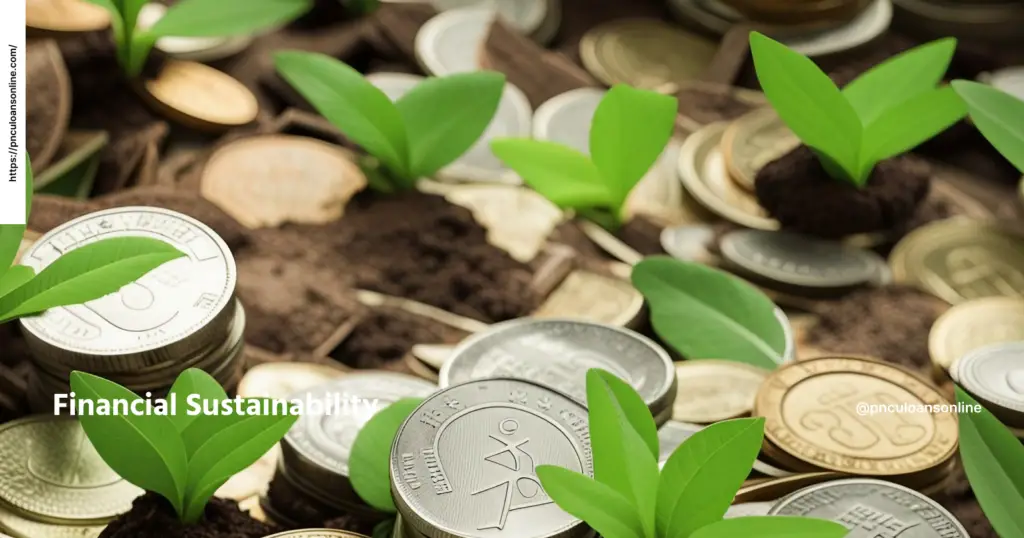Environmental protection and social responsibility are frequently at the forefront of our minds when we discuss sustainability. But financial sustainability is also a critical component of sustainability. In this post, we’ll look at how making an investment in a greener future can help you stay financially stable over the long run. We not only contribute to a healthy planet by making financial decisions that are in line with sustainable practices, but we also open up prospects for economic growth. Explore the field of financial sustainability to learn how we can have a good influence while safeguarding our financial future.
Sustainability and Finance in Context
Profit maximization has always been the driving force behind the financial sector, frequently at the expense of social and environmental consequences. But there is a paradigm shift toward sustainable investing as people become more aware of climate change and resource depletion. Financial sustainability acknowledges the connection between economic prosperity and the health of our world and society.

The Case for Sustainable Investing in Business
Allocating money to businesses that uphold environmental, social, and governance (ESG) objectives is known as sustainable investing. This strategy not only matches investments with individual values but also offers strong financial advantages. According to research, businesses that are devoted to sustainability typically outperform their competitors over the long term. They are better able to attract investors, handle risks, and adjust to shifting market circumstances. We can build portfolios that produce competitive financial returns while promoting positive change by including sustainability into investment methods.
Opportunities in Renewable Energy
Renewable energy is one of the most promising industries for sustainable investing. Renewable energy sources including solar, wind, and hydropower are increasing popularity as the globe looks for alternatives to fossil fuels. It can be profitable to invest in renewable energy businesses. Governments all around the world are also putting rules and incentives in place to quicken the switch to renewable energy, providing a favorable investment environment.
Supporting Green Infrastructure Investment
Green infrastructure offers yet another route to monetary stability. Investors have a sizable window of opportunity because sustainable urban development is necessary. In addition to helping to create a cleaner future, eco-friendly infrastructure, effective transit systems, and green buildings also provide good financial benefits. Investors may have a significant impact on how cities of the future are shaped by funding and supporting initiatives that encourage sustainable infrastructure.
Banking and Finance for Sustainability
Financial stability encompasses more than just individual assets. It includes bank and financial institution practices as well. ESG considerations are the main emphasis of sustainable banking when making loan and investing decisions. Banks can assist in the shift to a greener economy by funding sustainable ventures and projects. Additionally, ethical banking practices help reduce risks linked to unsustainable companies and save the environment.
Impact investing’s rise
Impact investment has been increasingly popular in recent years. This strategy places an emphasis on quantifiable beneficial social and environmental effects in addition to financial gains. Impact investors look for business opportunities that benefit society and the economy. Impact investors can create positive change while earning competitive financial returns by funding businesses and organizations that tackle urgent global issues like poverty, inequality, and climate change.
The Personal Contribution to Financial Sustainability
Large firms or institutional investors are not the only ones concerned with financial sustainability. People can also influence the future of the environment by making wise financial choices. Individuals can influence market demand and persuade businesses to use more sustainable methods by intentionally choosing to support sustainable goods and services. Additionally, people might look into environmentally friendly investment options including green bonds, socially conscious mutual funds, and community investment funds.
The Influence of Investing
For both individuals and organizations, divestment is a potent instrument for promoting financial sustainability. Investors can make a powerful statement to businesses and governments by divesting from industries that contribute to climate change, environmental damage, or human rights violations. Diversification campaigns have been successful in changing business behavior and legislation. We can have a real impact on the shift to a greener and more sustainable future by matching our investments with our ideals.
Defeating Obstacles and Accepting Change
Despite the tremendous opportunities it presents, financial sustainability is not without its difficulties. Systemic adjustments, cross-sector cooperation, and policy support are necessary for the transition to a greener future. Investors also require access to trustworthy data and indicators to assess the sustainability performance of businesses and projects. We can create a favorable atmosphere for financial sustainability and hasten the transition to a more sustainable and affluent world by addressing these issues as a group.
The Value of Knowledge and Awareness
The full embrace of financial sustainability depends on education and awareness. The need of educating people, companies, and politicians on the advantages of sustainable investing and the dangers of ignoring environmental and social factors cannot be overstated. By raising awareness, we may promote a mentality change and motivate more individuals to give consideration to financial sustainability when making decisions.
Furthermore, it is crucial to enlighten investors about sustainable investing possibilities and give them trustworthy information. Investors can make values-aligned decisions by having access to accessible reports on ESG performance and impact measures. The relevance of sustainability and its effect on long-term financial well-being should be emphasized in financial literacy programs that are promoted by financial institutions and groups.
Working together for a Greener Future
Collaboration between stakeholders from many sectors is necessary to achieve financial sustainability. To build an environment that supports sustainable finance, governments, corporations, financial institutions, and civil society must collaborate. This entails creating beneficial laws and policies, encouraging the advancement of eco-friendly technologies, and encouraging ethical business conduct.
Partnerships between the public and commercial sectors can help finance and invest in sustainable projects. In order to stimulate investments in renewable energy, green infrastructure, and sustainable enterprises, governments might offer incentives, subsidies, and tax breaks. Financial institutions can provide specialized investments and services that appeal to a wider spectrum of investors, making sustainable investing more appealing and accessible.
Overcoming Financial Sustainability Barriers
Although financial sustainability is gaining ground, there are still obstacles that must be overcome. The financial markets’ short-term orientation, which frequently favors quick profits above long-term sustainability, is a serious concern. This kind of thinking can obstruct the adoption of sustainable habits and investments in green projects. It takes a viewpoint change and an understanding of the importance of long-term sustainability to get past this obstacle.
Lack of uniform frameworks and measures for assessing sustainability success is another problem. To evaluate the environmental and social effect of their investments, investors require trustworthy and comparable data. The Task Force on Climate-related Financial Disclosures (TCFD) and Sustainability Accounting Standards Board (SASB), which offer guidelines for disclosing climate and sustainability-related risks, are two organizations working to create globally recognized reporting standards.
The Influence of Personal Choice
While group efforts are important, individual actions can have a big impact on financial sustainability. The following actions people can take can help create a greener future:
Consider banking with companies that encourage sustainable operations and fund renewable energy projects if you want to use sustainable banking solutions.

Support sustainable businesses: Give preference to organizations that show a dedication to sustainability in their operations, services, and corporate policies.
Invest sustainably: Look into green bonds, impact funds, or mutual funds that focus on environmental, social, and governance issues. People can encourage positive change and possibly generate financial returns by matching their investments with sustainability aims.
Reduce carbon footprint: Make deliberate decisions to cut your own carbon footprints by taking the bus, buying energy-saving products, and leading a sustainable lifestyle.
Promote change by speaking out in favor of laws and programs that advance fiscal stability. Participate in grassroots initiatives, interact with the neighborhood, and promote sustainable business or educational methods.
Conclusion:
Building a more sustainable future requires a commitment to financial sustainability. We can ensure our long-term financial stability while promoting a healthy planet by coordinating our financial choices with sustainable activities. We can have an impact while also producing competitive financial returns through sustainable investing, renewable energy, green infrastructure, and impact investing. Individuals can influence change by making sound financial decisions, such as divesting from unsustainable industries. Together, we can design a future where monetary success and environmental sustainability coexist together. Let’s invest in a greener future and seize the opportunities that financial sustainability offers.
FAQs:
What is a sustainable financial position?
The technique of coordinating financial choices and investments with ethical and responsible values is known as financial sustainability. Making financial decisions requires taking environmental, social, and governance (ESG) considerations into account. Individuals and organizations can ensure their long-term financial security and contribute to a greener, more sustainable future by incorporating sustainability into their financial strategy.
How does financial stability result from investing in a greener future?
Financial security can result from investing in a greener future in a number of different ways. First, over the long term, sustainable investments frequently outperform their non-sustainable equivalents. Businesses that place a high priority on sustainability are typically better able to control risks, adjust to shifting market conditions, and draw investors.
Additionally, there are huge potential in industries like renewable energy and green infrastructure as the globe moves toward a low-carbon economy. By making investments in these sectors, one can help build a more robust and sustainable economy while also earning appealing returns.
What are some chances for investing in sustainability?
Opportunities for sustainable investing abound. Renewable energy is one significant area, which involves funding solar, wind, and hydropower projects. Governments everywhere are putting laws and incentives in place to assist the switch to renewable sources of energy because there is an increasing demand for clean energy.
The financing of initiatives that support sustainable urban development, such as energy-efficient structures, environmentally friendly infrastructure, and sustainable transportation systems, is another potential. These investments don’t just support a future with less pollution.
What role may individuals play in ensuring financial stability?
Through their financial decisions and deeds, people can support financial sustainability. They can decide to promote ESG principles and environmentally responsible business practices that prioritize sustainability. People may be sure their money is being invested responsibly and sustainably by choosing sustainable banking choices.
Additionally, people can look at environmentally friendly investing options that support favorable social and environmental results, such as socially conscious mutual funds or green bonds. The transition to a greener future can be accelerated by individuals by lowering their carbon footprint and supporting change.
What obstacles must be overcome to achieve financial sustainability?
Even while financial sustainability is moving forward with increasing velocity, there are still obstacles to be addressed. One issue is the financial markets’ tendency to prioritize short-term gains above long-term sustainability. It is essential to change this perspective and emphasize the need of long-term sustainability.
Lack of uniform frameworks and measures for assessing sustainability success is another problem. To evaluate the environmental and social effect of their investments, investors require trustworthy and comparable data. In order to offer rules for exposing hazards related to sustainability and the climate, efforts are being made to create universally endorsed reporting standards.

